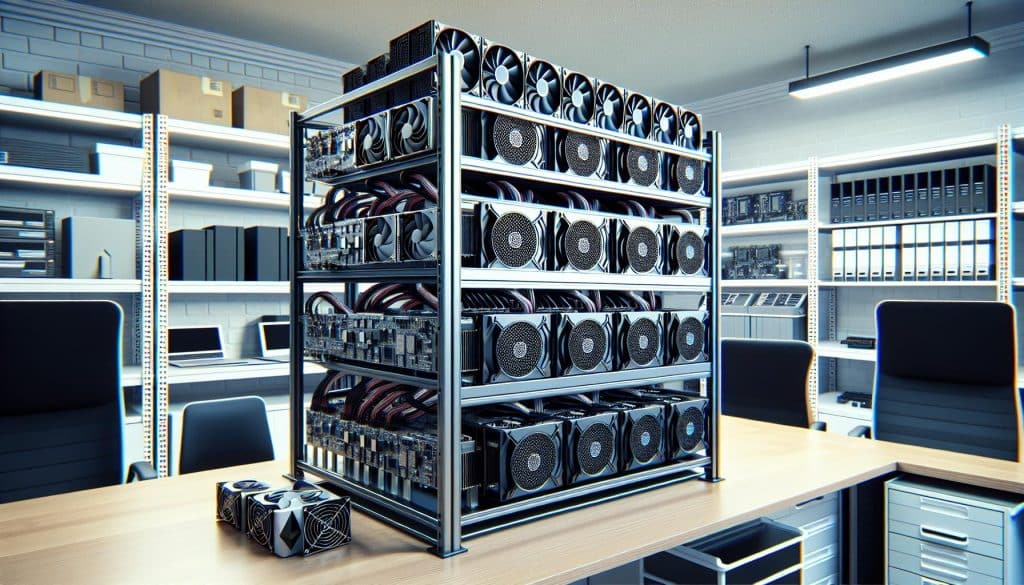You’ve likely heard of Ethereum, the second-largest cryptocurrency by market capitalization. But have you ever wondered about the process behind its creation? That’s where Ethereum mining comes into play, a fascinating and potentially lucrative endeavor.
In the world of cryptocurrencies, mining is the heartbeat that keeps the system alive. It’s not just about making money, but also about maintaining the integrity and functionality of the Ethereum blockchain.
In this article, we’ll demystify the process of Ethereum mining. We’ll guide you through the steps, equipment, and strategies you’ll need to get started. Whether you’re a tech enthusiast or a seasoned investor, there’s something for you to learn here. So let’s dive in and unearth the secrets of Ethereum mining.
Key Takeaways
- Ethereum, the second-largest cryptocurrency, operates on a Proof-of-Work consensus algorithm. It’s not just about making money but maintaining the integrity and functionality of the Ethereum blockchain.
- Ethereum mining involves creating new blocks, finalizing and including verified transactions in a new block, and solving mathematical problems to determine the next block to be added to the Ethereum blockchain.
- High-performance Graphic Processing Units (GPUs) and adequate Random Access Memory (RAM) are crucial for mining Ethereum. Both components enhance the efficiency of transactions and the handling of complex mining tasks.
- Mining Ethereum also requires selecting an appropriate operating system, assembling the right hardware, and installing the right mining software. Leading software options include Claymore’s Dual Ethereum Miner, Phoenix Miner, Ethminer, and Minergate.
- Joining an Ethereum mining pool can increase the chances of earning rewards. These pools are clusters of miners working together to solve blocks and share rewards.
- Protecting your mined Ethereum and maintaining your mining rig is important for the safety and efficiency of your mining operations. Regular checks, cleaning, and updates of your software and hardware are necessary.
- Calculating the Profitability of Ethereum Mining involves understanding profit calculation and knowing the factors that affect profitability: Hashrate, Power Consumption, Pool Fees, and Ethereum Price. There are tools available, such as CryptoCompare’s Ethereum Mining Calculator or Whattomine.com, which can help calculate potential returns from your mining efforts.
Understanding Ethereum
Let’s dive in to gain a comprehensive understanding of Ethereum beyond just its ability to be mined.
About Ethereum Blockchain
Ethereum, unlike other digital currencies, acts as a decentralized software platform enabling Smart Contracts and Distributed Applications (DApps). These applications function without downtime, fraud, control, or interference from third parties. Ethereum blockchain is a global, open-source platform for decentralized applications. It’s not just a platform but also a programming language(Rust, Go, C++) running on a blockchain, assisting developers in publishing widely used applications.
A key feature of Ethereum’s support for code execution via a feature called Ethereum Virtual Machine(EVM). EVM runs the same code on many different machines, producing a universal execution machine. Ethereum’s native token, commonly known as Ether(ETH), is used primarily for two purposes: transaction fees for operations and as an application layer, enabling Decentralized Finance (DeFi) applications.
For readers interested in the value proposition, the Ethereum blockchain presents two aspects: functionality and speculatively. Its functionality derives from smart contracts and DeFi, while SPECULATIVELY comes from ether’s potential value.
How Ethereum Mining Works
Ethereum propagation operates on a Proof-of-Work (PoW) consensus algorithm (a system that curbs abuse by requiring work in the form of computational power). ‘Miners’ around the world run software and use computational power to solve complex mathematical problems.
Once a problem is solved, a new block is added to the Ethereum blockchain, and the ‘miner’ who solved the problem is rewarded with a certain amount of Ether coins. This reward offers an incentive for more people to become miners, increasing the number of miners and thus the overall security of the network.
On the Ethereum platform, blocks are mined approximately every 15 seconds, significantly faster compared to Bitcoin’s 10 minutes, for instance. Nonetheless, in time Ethereum aspires to change its consensus algorithm to Proof-of-Stake (PoS) with the Ethereum 2.0 update, aiming to become both more energy-efficient and able to process transactions faster.
Mining Ethereum involves creating new blocks, checking and verifying transaction details, finalizing and including verified transactions in a new block, and solving a complex mathematical problem to determine the ‘winning’ block to be added to the Ethereum blockchain. It’s primarily the work of assembling transactions into blocks, doing the hard work to seal off those blocks, and then adding them to the block chain.
The procedure, though seemingly complex, provides transparency and maintains the legitimacy of Ethereum. It’s a lynchpin, ensuring the integrity of smart contracts, making Ethereum truly decentralized. It’s confirmed that there are over 100 million BitEther in circulation with the maximum potential supply being infinite. Ethereum mining, therefore, continues to serve as the backbone of Ethereum’s network, securing Ether transactions and driving decentralization in the process.
Necessary Hardware for Mining Ethereum

Equip yourself with the right hardware to mine Ethereum. You’ll be tackling complex computational tasks that require specific computer components. Let’s explore the relevance of Graphic Processing Units (GPUs) and why Random Access Memory (RAM) is critical.
Recommended Graphic Processing Units (GPUs)
GPUs serve as the backbone of Ethereum mining. Their ability to handle repetitive computational tasks coincides perfectly with Ethereum’s Proof-of-Work algorithm. NVIDIA and AMD manufacture some of the top GPUs for mining Ethereum. The NVIDIA RTX 3080, for instance, offers hash rates above 80 MH/s, signifying high transaction verification speed. On the other hand, AMD’s RX 6800 XT, provides similar acceleration with lower power consumption. When buying GPUs, consider the hash rate, power usage, and cost to ensure optimal performance for the Ethereum mining procedure.
Importance of Random Access Memory (RAM)
RAM plays a vital role in the Ethereum mining landscape. More RAM capacity allows your machine to handle more complex operations and mining tasks. Accompanied by a high-performance GPU, having at least 8GB of RAM becomes essential for seamless Ethereum mining operations through increased transaction verification speeds. For instance, Ethash, Ethereum’s mining algorithm, stores a dataset in the RAM. Having a larger RAM capacity can handle this operation, enhancing the mining procedure. RAM doesn’t directly influence mining performance, but a shortage can limit your GPU’s efficiency or disable mining altogether.
Setting up Your Ethereum Mining Rig
Having the right hardware is only the first step when mining Ethereum. Further refining your mining process entails selecting an appropriate operating system and assembling your mining rig. With highly performant GPUs like NVIDIA RTX 3080 and AMD RX 6800 XT and adequate RAM, you can perform complex mining tasks efficiently.
Choosing and Installing the Right Operating System
Being the backbone of your mining operation, the right operating system can boost your mining performance significantly.
A popular choice among Ethereum miners is the EthOS operating system. This Linux-based software has been tailored for Ethereum mining and offers features that help streamline the mining process. It supports both NVIDIA and AMD GPUs, allowing you to maximize hash rates for increased mining productivity.
Another viable option is Microsoft’s Windows 10, known for its easy-to-use interface and extensive community support. While it’s not optimized specifically for Ethereum mining, the broad compatibility with mining software makes it a suitable choice for beginners.
Finally, Simple Mining OS (SMOS) stands as another reliable operating system for Ethereum mining. SMOS offers handy features such as overclocking and online monitoring, aiding in the optimization of your mining rig’s performance.
Assembling the Hardware
Assembling your Ethereum mining rig requires diligence and precision. Your main unit, the GPU, communicates with other components on your rig, making its installation crucial.
Start with installing the GPU onto your motherboard. Both NVIDIA RTX 3080 and AMD RX 6800 XT will fit into the PCIe slots on most motherboards. Ensure the GPU is firmly seated and locked into its place.
Next, connect the power supply. Your high-performance GPUs will draw plenty of power, making a high-capacity power supply unit essential. Consider a power supply with at least 1200W capacity.
The final setup in your assembly should be the installation of your RAM. Remember, adequate RAM helps handle complex mining tasks, optimizing your Ethereum mining operations. Make sure the RAM is compatible with your motherboard and securely placed in its designated slot.
Keep these steps in mind while setting up your Ethereum mining rig. Tackling each task with precision helps ensure a smooth and efficient mining operation. Bear in mind, though, it’s not just about assembling the right hardware—it’s also vital to install and use the optimal operating system for your needs. Accomplishing these steps gets you closer to successful Ethereum mining, readying you for the world of Ethereum ETFs and fintech-focused Ethereum endeavors.
Selecting the Right Mining Software
When embarking on the Ethereum mining journey, the selection of the right software carves the pathway to optimal mining performance. Having a strong understanding of Ethereum mining software’s workings and the leading options available is a necessity for a profitable venture.
Understanding Ethereum Mining Software
Mining software is your ticket to Ethereum mining. It forms a crucial connective link between your hardware and the Ethereum blockchain. It translates vital raw data, generates mining work to your GPUs, collects results, and sends correct solutions back to the blockchain. Several factors affect the software suitability, such as GPU compatibility, the friendliness of the user interface, and the software’s efficiency in resource use.
Keep in mind, top-quality software assists in maximizing the hash rate — an important indicator of how many Ethereum mining calculations your hardware can run per second. Remember, higher hash rates potentially lead to higher rewards.
Leading Mining Software Options
Diverse choices for Ethereum mining software are in the market, with each boasting unique features. A couple of notable options are:
- Claymore’s Dual Ethereum Miner: Renowned for its dual mining feature, Claymore allows you to mine Ethereum alongside other cryptocurrencies, such as Decred, without hampering Ethereum’s hash rate. It’s well-suited for Windows and Linux operating systems.
- Phoenix Miner: This fast, cost-effective option offers one of the highest hash rates in market. Compatibility isn’t an issue as it’s efficient with both AMD and NVIDIA cards. It’s user-friendly and enables fine-tuning of GPU settings right from the mining console.
- Ethminer: The open-source Ethminer shows impressive compatibility as it supports GPUs from both NVIDIA and AMD. It also prioritizes data privacy by offering local mining without requiring any external servers.
- Minergate: If you’re searching for a simple-to-use Ethereum mining software, Minergate might serve you well. It provides a smooth user experience and a GUI that eases the process for beginners.
Ultimately, the selection of mining software depends on your specific needs, resources, and technical proficiency. Spend time experimenting with different options to identify the software that best aligns with your Ethereum mining objectives.
Joining an Ethereum Mining Pool
Joining an Ethereum mining pool is a pivotal step in your Ethereum mining journey. These pools are clusters of miners working together to solve blocks and share rewards, boosting your chances of earning rewards.
Understanding Mining Pools
In the realm of crypto mining, Ethereum mining pools are proven instrumental. A mining pool amounts to an alliance of miners who put their hardware resources together, concentrating their computing power, and equating to a higher collective hash rate.
Illustrating this, let’s imagine five miners, each with a hash rate of 20 Megahash per second (MH/s), decide to form a pool. Consequently, their combined hash rate turns to 100 MH/s, radically augmenting their chances of validating a block ahead of solo miners or even smaller pools. Payouts are, in return, distributed among pool members based on the work they’ve contributed, measured by ‘shares’.
How to Choose the Right Mining Pool
Selecting the right mining pool is not a hasty decision. Here are some key factors you must consider:
- Size: Larger pools provide more regular, but smaller rewards, while smaller pools offer larger, but less frequent payouts.
- Payment structure: Ethereum mining pools employ different payout models. These include Pay Per Share (PPS), where miners receive a set payment for each share they submit, regardless of whether a block is solved or not, and Full Pay Per Share (FPPS), where transaction fee rewards are also included with block rewards.
- Pool fee: This is the percentage of your earnings that the pool extracts as a fee for its services. Smaller fees translate to higher earnings but may come with comprosises, such as less reliable services.
- Reliability and security: Ensure the pool is reputable, reliable, and secure. Check out community feedback and reviews online. A pool with low downtime and robust security protocols is preferable.
- Geographic location: Prefer joining pools with servers near your physical location. Proximity reduces latency and increases your mining efficiency.
As an illustration, consider ethermine.org, known for its reliability and low fees, or Ethpool, favored for its user-friendly interface.
By carefully considering these factors, you can choose an Ethereum mining pool that aligns with your objectives and resources. Remember, mining’s not just about equipment; it’s also about strategy, and the right pool plays a significant role.
Important Safety Measures
Mining Ethereum requires diligent safety measures. Predominantly, they encompass protection for your mined Ethereum and the maintenance of your mining rig. The guidelines detailed below explain precautionary steps that secure the success of your Ethereum mining.
Protecting Your Mined Ethereum
Safeguarding your mined Ethereum is paramount. Encrypting your wallet is the starting point. Cryptocurrency wallets support encryption, allowing for a strategic line of defense against attackers. Use this encryption feature to shield your Ethereum from any hacking attempts.
One example of a robust encrypted wallet is Ethereum Wallet, a dynamic solution for storing, managing, and transacting Ethereum safely. Known for its financial-grade security features, it’s an optimal choice for Ethereum miners.
Another critical approach is updating your wallet software regularly. Updates often include improved security measures and patches for any vulnerabilities. An outdated wallet application risks the security of your stored Ethereum. Make sure to keep your software updated, which is, in most cases, a simple process that can be automated. The last strategy is employing hardware wallets. If you’re mining huge amounts of Ethereum, invest in a hardware wallet. A device resembling a USB stick, it provides optimal security as it’s offline most of the time, reducing chances of a cyber-attack.
Maintaining Your Mining Rig
Your mining equipment’s maintenance is also critical for your Ethereum mining success. Regular checks and cleaning are essential to guarantee the longevity of your hardware.
One effective strategy involves monitoring your rigs’ temperature. Mining strains your hardware, and this strain translates to heat. Overheating can hinder your mining operation significantly, leading to hardware failure. Opt for programs like MSI Afterburner which allow temperature monitoring and provide handy overclocking features.
Also, dust poses a significant threat to your rig’s functionality. Buildups can block ventilation and cause overheating, reducing your hardware’s lifespan. Thus, regular cleaning is necessary.
Further, keep your mining software updated. Similar to your wallet software, updated mining programs promise better performance. They include patches for bugs and enhanced functionalities that boost device efficiency. Examples to consider include Claymore, Phoenix Miner, or Geth. They’re well-maintained, frequently updated, and offer a multitude of quality features.
Lastly, always ensure that the hardware is operating under optimal conditions. Maintain a cool and dry environment to limit any exposure to moist conditions. Such conditions could instigate issues like short-circuits or rust, leading to rig damage.
By adopting these vital safety measures, you increase the efficiency and longevity of your Ethereum mining operation, stumping potential threats and reaping the rewards to a higher degree.
Calculating Profitability of Ethereum Mining
After mastering the art of mining and adhering to safety measures, the next logical question, possibly the most crucial, comes to light: How profitable is Ethereum mining? This section deliberates on the profitability variables and how to calculate potential returns from your investment in Ethereum mining.
Understanding Profit Calculation
To discern the potential profitability of Ethereum mining, one ought to consider several variables. These variables derive directly from costs incurred and earnings accrued during the mining process. Ethereum mining calculators, for instance, CryptoCompare’s Ethereum Mining Calculator or Whattomine.com, serve as commendable tools, providing precise profit projections based on these variables. You feed in details of your mining setup, such as hashing power, power consumption, cost per KWh, and pool fees. The output projects your potential earnings considering prevailing Ethereum price, transaction fees, and block rewards against your operational costs.
Variables Affecting Profitability
The profitability of Ethereum mining experiences influences from numerous factors. Here’s a rundown of primary variables:
- Hashrate – A miner’s hashrate, measured in hashes per second (H/s), depicts the mining power. More power increases the likelihood of finding the next block, hence earning more Ether.
- Power Consumption – Mining hardware, especially GPUs, consume substantial electricity, which forms a significant chunk of operational costs. Optimal power usage enhances profitability.
- Pool Fees – Mining in a pool often attracts fees, typically a percentage of earned Ether. High fees can erode potential profits.
- Ethereum Price – As Ether price fluctuates, so does potential profitability. An increase enhances profits, while a decrease threatens to turn operations into a loss.
Equipped with the knowledge of these variables and using a mining calculator, you can forecast potential profitability, ensuring you’re not running a futile operation. Keep in mind, however, that mining Ethereum, like other cryptocurrencies, isn’t a guaranteed meal ticket, but a venture with its risks and uncertainties.
Conclusion
So you’ve navigated the complexities of Ethereum mining. You’ve learned how crucial hardware selection is and that the right software can enhance your performance. You’ve understood the importance of joining mining pools and how they can boost your rewards. You’ve also noted the factors to consider when choosing a pool.
You’ve grasped the significance of protecting your mined Ethereum and maintaining your mining rigs. You now know that profitability isn’t guaranteed but can be projected using tools like Ethereum mining calculators.
Ethereum mining isn’t just about earning Ether. It’s a meticulous process that requires careful planning and constant vigilance. It’s a journey filled with risks and uncertainties but also potential rewards. As you embark on this venture, remember the lessons you’ve learned and always stay updated. Your success in Ethereum mining lies in your hands.
What is the role of Ethereum mining?
Ethereum mining involves validating transactions on the Ethereum blockchain to earn rewards known as Ether. It maintains the blockchain’s autonomy and security, primarily through the Proof-of-Work consensus mechanism.
What hardware do I need to mine Ethereum?
Ethereum mining requires a powerful GPU, preferably with 4GB or more RAM. You also need sufficient storage, a stable internet connection, and software to run your mining operations.
Why is choosing the right mining software crucial?
The right mining software is optimized for your system and aims at delivering the highest mining performance possible. It also aids seamless integration with your chosen mining pool.
Why should I join an Ethereum mining pool?
Mining pools combine the computational power of individual miners to increase chances of earning rewards. They distribute these rewards among participants, making them a more dependable option than solo mining.
How do I choose the right mining pool?
Consider factors such as pool size, payment structure, fees, reliability, and geographic location when choosing the right mining pool. Websites like ethermine.org and Ethpool are examples of reputable mining pools.
How can I ensure the safety of my Ethereum from mining?
Maintain your mining operation’s security by encrypting your mined Ethereum, regularly updating wallet software, and using hardware wallets.
How do I maintain my mining rig?
Regularly monitor the temperature of your mining rig, keep it dust-free, and frequently update both hardware and software to ensure efficient operation.
How is Ethereum mining profitability calculated?
Profitability is determined by factors such as your hashrate (mining power), power consumption, pool fees, and price fluctuations of Ethereum. Tools like an Ethereum mining calculator can help you estimate potential earnings.







